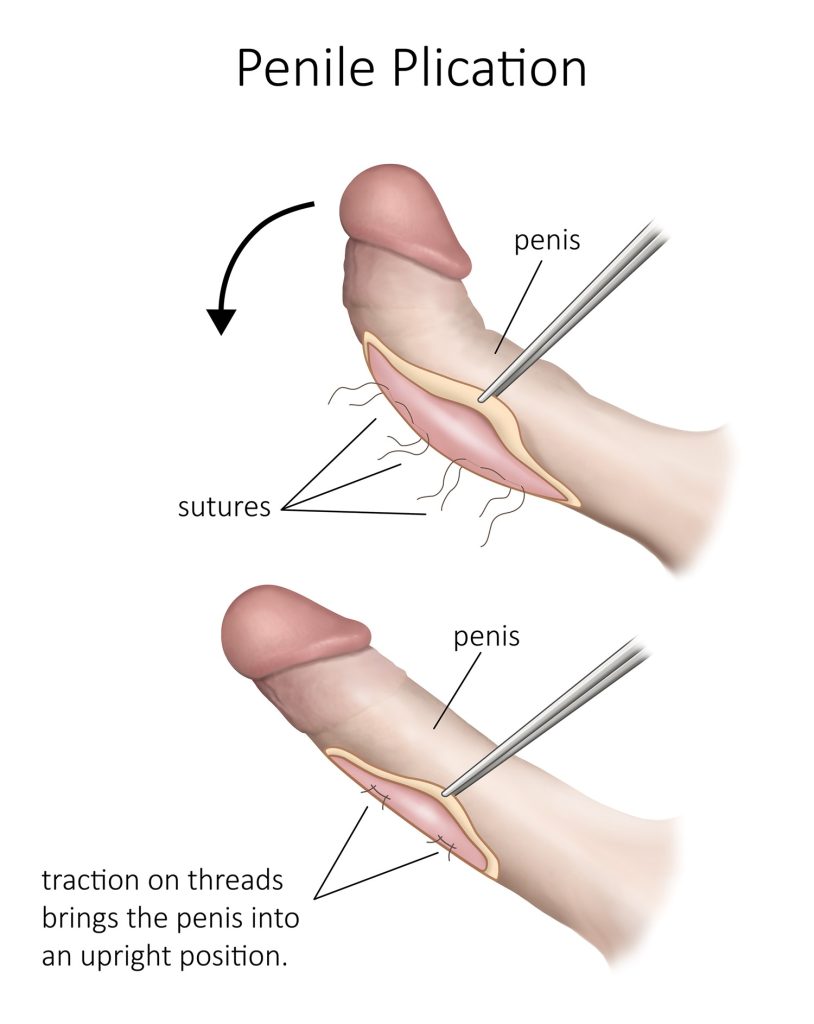Corrective surgery is necessary in less than 10% of cases. The goal of this procedure is to decrease the amount of curvature of the erect penis to facilitate intercourse. Straightening of the penis by plication is performed only if severe penile curvature prevents intercourse or makes it difficult for at least 12 months. It is recommended for patients who have good erectile ability, who have a simple deformity (one direction) and less than 60 ° and who have a penis with sufficient length.
Patients may be asked for photos of their erect penis; the latter will help the urologist validate the operative technique and to judge the postoperative result.
Straightening the penis by plication is intended to shorten the tunica albuginea by excising an albuginea tunica ellipse on the opposite side to the curvature with nonabsorbable point suture. The results are very satisfactory; a success rate ranging from 79% to 100% for realignment and from 67% to 100% for patient satisfaction is reported.
- It is best to shave the pubic area beforehand to facilitate the application of an anesthetic cream.
- Post-operative care for straightening the penis by plication is the same as for circumcision.
- Pain relievers will be prescribed and one has to:
- Avoid any sexual activity (with erection) for six weeks after the operation to allow healing.
- Avoid any strenuous physical exertion for a week.
- Plan to take a leave of absence from work, if necessary (standing or physically demanding occupations).
- A postoperative appointment will be scheduled two months after the operation to assess the quality of healing.
- Pictures of the erect penis may be requested in order to help in the assessment, if one wishes to avoid traveling to one of the clinics.


How is the penile plication for Peyronie’s disease performed?
After anesthesia, an artificial erection is performed using an intravenous injection of a medication, to choose the location and the number of plications to make.
In general, the skin incision is made a few millimeters behind the glans in a circular way to deglove the skin of the penis on the cavernous body (degloving). In an uncircumcised patient, circumcision is generally proposed to avoid complications related to postoperative edema. In a circumcised patient, the incision is located at the level of the old scar.
Then the skin is closed using resorbable threads. A bandage wrapped around the penis is left in place.
A bladder catheter may be required within the first 24 hours after the procedure.
What are the risks and complications of a penile plication for Peyronie’s disease?
Failure of the intervention.
Decreased penis width at rest or erection.
Perception of nodules under the skin of the penis, related to the palpation of non-absorbable threads.
Pain during sex
Progressive recurrence of Peyronie's disease.
Local complications (hematoma, infection and urinary retention) are occasional. Disorders of the sensitivity or vascularization of the penis (transient or permanent) are exceptionally rare.


